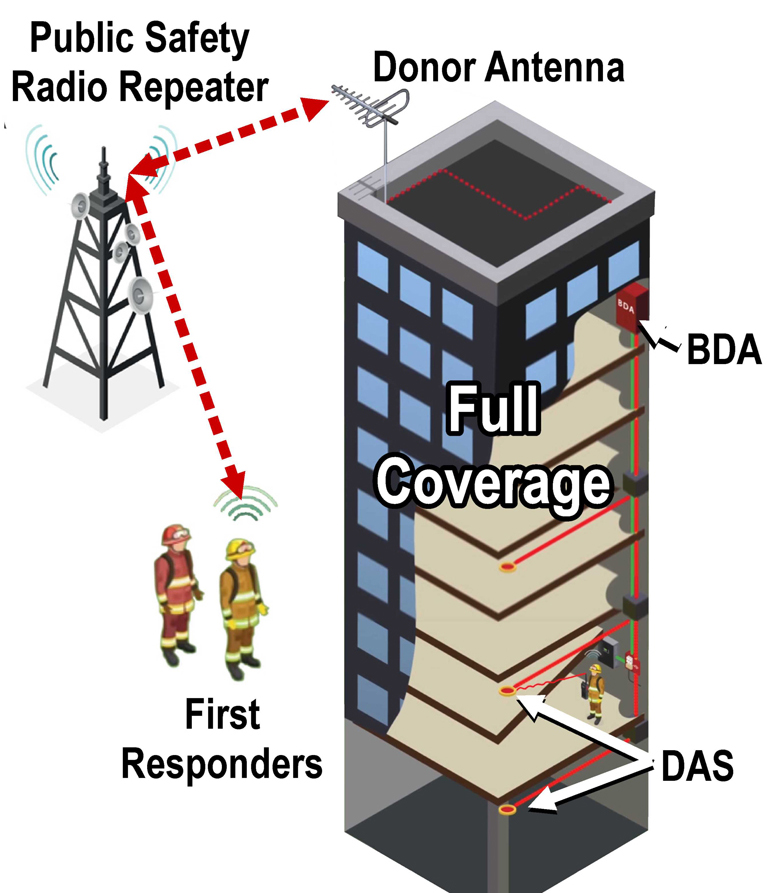EMERGENCY RESPONDER RADIO COMMUNICATION SYSTEM (ERRCS)


WHAT IS AN ERRCS?
It is now a requirement in many buildings around our country to have an ERRCS, or Emergency Responder Radio Communication System, implemented. ERRCS serves as an in-building communication system that improves critical communications inside and outside a building. An extension of the public safety network, ERRCS utilizes a series of smaller antennas that form a Distributed Antenna System (DAS). This allows all users to transmit and receive radio signals from the network of first-responders.
The ERRCS is made up of a few components that professionally installed inside a building. This is achieved by connecting a Bi-Directional Amplifier (BDA) system to the donor antenna. This antenna is used to transmit and receive proper radio frequencies from the local public safety network. The BDA summarily connects via fiber or cable to a DAS. This is where signals are then re-amplified completely throughout the building in areas that without have poor or, at best, limited coverage.
Typically set by the “authority having jurisdiction,” requirements for a municipality are determined by the contact point, such as a fire marshall or similar to maintain local codes. These recommendations are based on International Fire Code (IFC), section 510, and the National Fire Protection Association (NFPA), code 72.
In recent times, the requirements for building safety and communication systems set forth by the IFC and NFPA have been updated summarily. While this is not an all-encompassing list, here are some typical requirements for public safety compliance and ones your building’s management should strongly consider before installing an ERRCS.
COMMON REQUIREMENTS
BUILDING SIZE
ERRCS are required on buildings three or more stories or with an area greater than 50,000 square feet or containing underground parking. The bigger a building is, and the more complex, the more difficult it is to keep the signal strong in every area. Buildings are often constructed from dense materials like concrete, metal, wood, brick, and low-E glass. This can disrupt or completely block communication signals entering and leaving said building.
Also playing a part in interference are multi-room layouts and thick walls. Ensuring the proper RF signal has amplification throughout the building will help to see to safety and communication, which is pertinent for IFC compliance.

LICENSING REQUIREMENTS
Special training and an FCC General Radiotelephone Operator License (GROL) are requirements to adjust, repair, or maintain FCC (Federal Communications Commission) radiotelephone transmitters. Choosing a reputable company such as Harris Security Systems to perform testing and installation of your responder system is important to ensure compliance.
FREQUENCY REQUIREMENTS
It’s necessary to amplify certain radio frequencies used for emergency services within commercial buildings. Harris Security Systems will place DAS or signal boosters in specific areas of buildings. This ensures the safety of all occupants and their safe evacuation from the building in the event of an emergency.
SIGNAL STRENGTH
Buildings need to have a 95% majority of minimum signal strength of -95 dBm. Emergency responder communication units use this standard signal strength. The DAS boosts the signal enough so that it meets the requirement.
SIGNAL TESTING
ERRCS testing is a requirement for compliance. In order to keep interference to a minimum and to ensure critical safety standards, annual testing and maintenance of all emergency systems is vital. Harris Security Systems is licensed, certified, and has detailed knowledge of the current codes.

ERRCS is a Code-Driven Requirement:
- IBC 2015 – Section 916, NFPA 1 Section 11-10: Refers to IFC section 510 or the state recognized fire code.
- IFC Section 510 Emergency Responder Radio Coverage: First appeared in the appendix of the 2009 IFC; the provision was moved to the body of the code in 2012. Section 1103.2 specifies the requirements for emergency responder radio coverage in existing buildings.
- NFPA 72 National Fire Alarm and Signaling Code: 2010 / 2013 Edition, section 24.5.2. The 2016 edition of NFPA 72 relocated the requirements to NFPA 1221. 2016 & 2019 Editions of NFPA 1221, Emergency Service Communications Systems, 2016 & 2019 Editions of NFPA 1221, Emergency Service Communications Systems, Section 9.6.
ERRCS and BDA FAQ’s:
Does the Building Code require BDAs for Police and Fire Departments?
The code requires coverage for Emergency Responders. The AHJ will determine which Emergency Responder agencies need to be included in the system. Generally, it includes Fire, Fire Mutual Aid, Police and EMS.
What skills, education, or experience must a technician have to install, commission, and service a BDA system?
This depends on the jurisdiction, but typically FCC GROL or approved equivalent and manufacturer certification.
How does one determine whether existing radio coverage is adequate, or justify whether an Enhancement System is warranted?
A RF Survey must be performed. Typically performed by specialized FCC GROL certified technician and some fire department radio personnel, a RF Survey is accomplished by measuring the Downlink/Uplink signal strengths in decibels-milliwatts (dBm) using special measuring devices.
The survey can be determined before the building construction starts with a signal survey on the building site followed by software-simulated radio propagation modeling. This results in heat maps that show predicted signal coverage levels.
Results are submitted to AHJ to determine if a BDA is required or if a waiver is appropriate.
What is the UL2524 Product Standard?
The UL2524 creates a product performance standard that allows manufacturers to design and list BDA systems to.
UL2524 assures AHJs, A&Es, Building Owners and Occupants that Notifier’s BDA systems perform the first time and every time – exactly as prescribed in IFC 510.5.3 and NFPA 1221.
What are NFPA’s requirements for annunciator at FACP or is FACP monitoring adequate?
A dedicated alarm panel must be located in the fire command center or other location designated by the AHJ. The BDA status must also be monitored by the building’s fire alarm system.
How does a system designer or system engineer determine what frequencies are to be supported?
The AHJ is required to maintain a document of technical information specific to these requirements.


